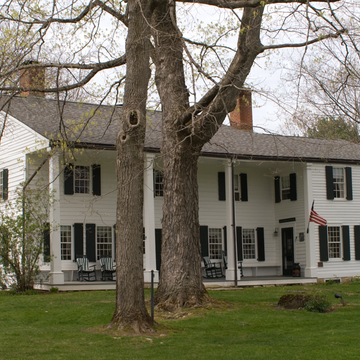One of the oldest extant houses in Vermont, the Henry house displays rare and well-preserved Georgian vernacular features that reveal much about building in the Bennington area in the late eighteenth century. It was built in two campaigns. In 1769 Elnathan Hubbell from Stratford, Connecticut, constructed a five-bay eaves-front house with a paneled central door on strap hinges and a central chimney. About 1797 the house was acquired by William Henry, who arrived in Bennington from Ireland via Colrain, Massachusetts, to serve as a home, tavern, and store near his mills in what came to be known as Irish Corner. He rebuilt what may have been an original north wing as two stories and tied it to the main house with a full-height porch formed by altering and extending the main front roof to rest on colossal posts with beaded corners and complexly molded bases and capitals. This porch and an original one-story porch (later enclosed) across the rear of the house are unusual for the time, but their contemporary appearance in the Hudson Valley suggests the New York connections of the Bennington area. Other than Henry's removal of the central chimney and insertion of a central hall with a straight-run staircase, the interior of the main house remains essentially intact. It includes encased girts and gunstock posts, original woodwork and trim, and a second-floor ballroom. In the 1920s this house and three others at Irish Corner were acquired by Hall Park McCullough of North Bennington, who restored them as summer houses for his family. His heirs conveyed this house to the Preservation Trust of Vermont in 1985.
You are here
William Henry House
If SAH Archipedia has been useful to you, please consider supporting it.
SAH Archipedia tells the story of the United States through its buildings, landscapes, and cities. This freely available resource empowers the public with authoritative knowledge that deepens their understanding and appreciation of the built environment. But the Society of Architectural Historians, which created SAH Archipedia with University of Virginia Press, needs your support to maintain the high-caliber research, writing, photography, cartography, editing, design, and programming that make SAH Archipedia a trusted online resource available to all who value the history of place, heritage tourism, and learning.


